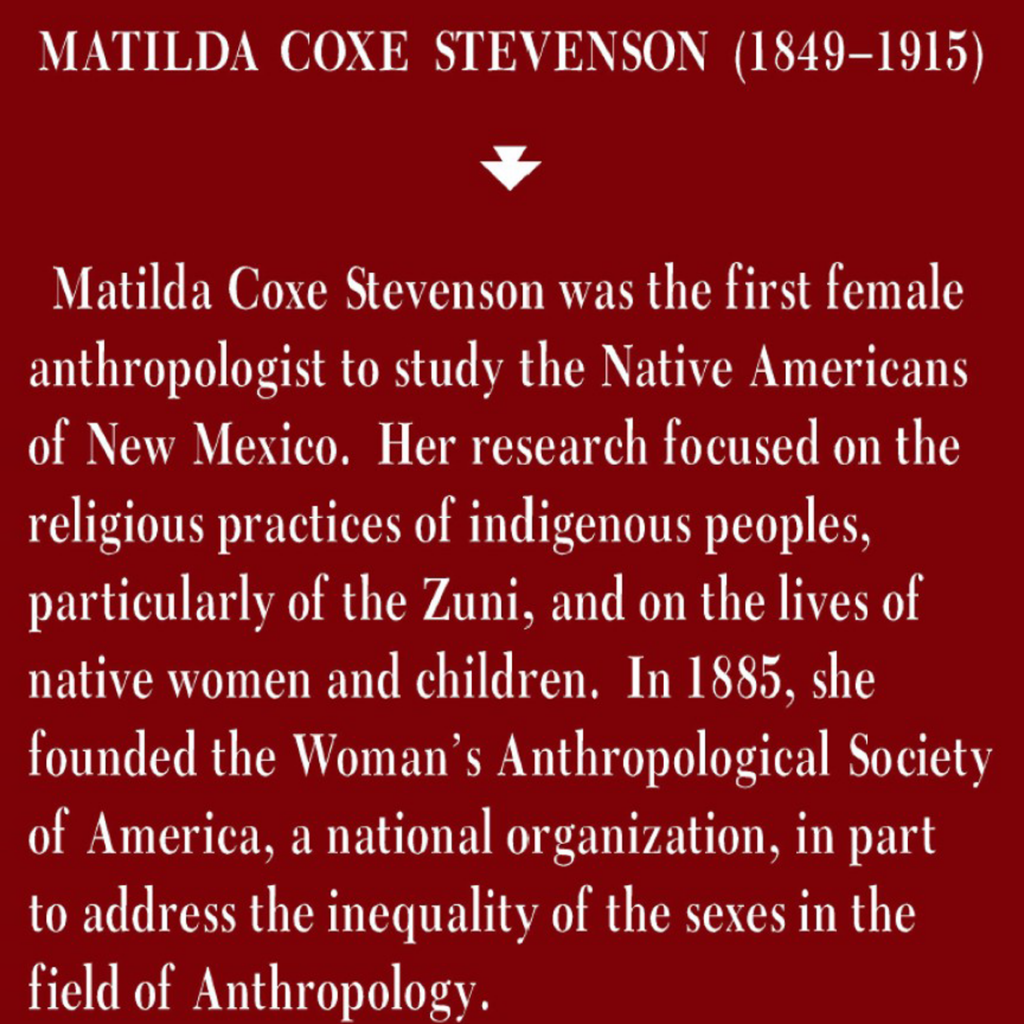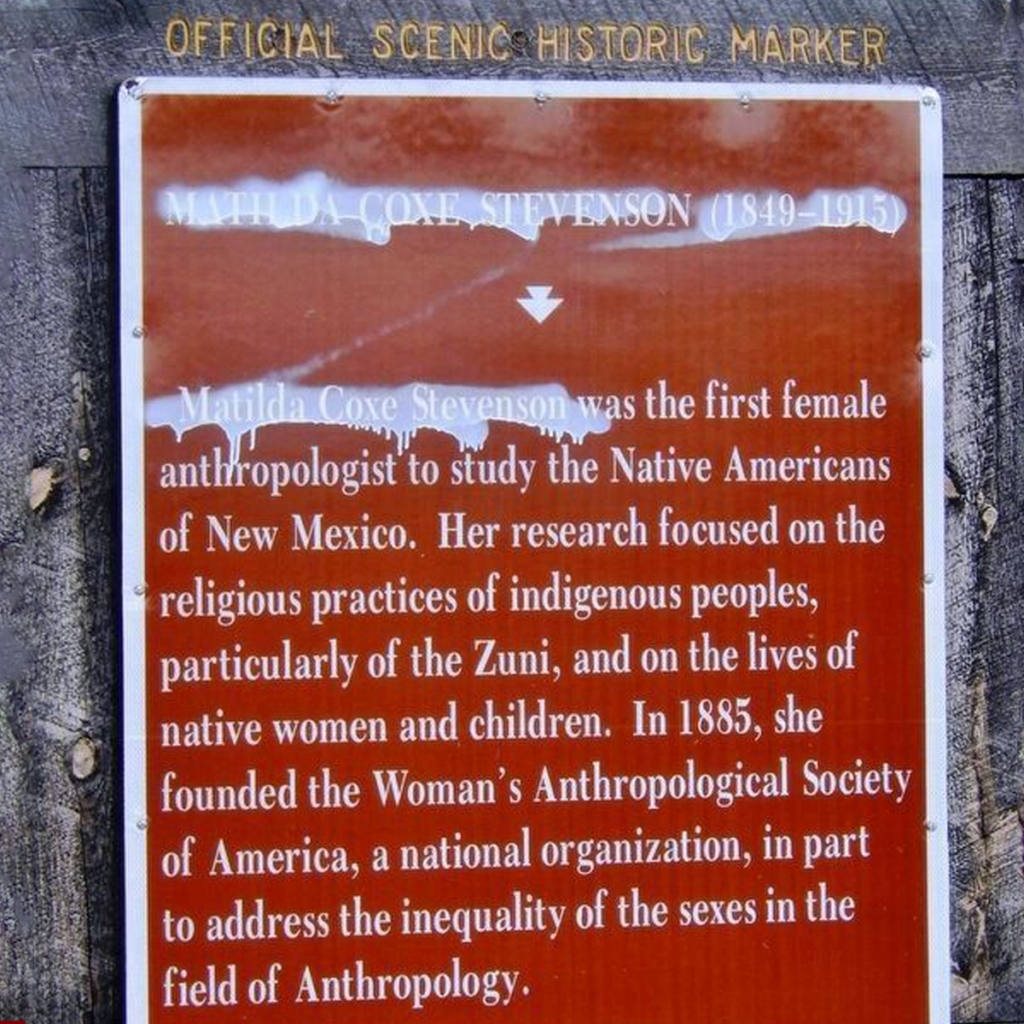Matilda Coxe Stevenson historic marker.
Photo Credit: Courtesy of New Mexico Historic Women Marker Program. Courtesy of New Mexico Historic Women Marker Program.
Matilda Coxe Stevenson
1849 - 1915
Cibola County
The first woman employed as an anthropologist anywhere, she was a pioneer in her field by any measure and her work has withstood the test of time. She devoted her life to the study of Native Americans of New Mexico, leaving an important body of research for scientists and indigenous communities.
When Matilda Coxe Stevenson moved to New Mexico with her husband, she became interested in her husband’s research at Zuni Pueblo. While she initially only helped with his research, she soon started her own research projects, ultimately becoming a pioneer in Native American anthropology.
The daughter of Alexander Hamilton Evans and Maria Coxe Evans, she chose to keep her mother’s maiden name, going by Matilda Coxe until her 1872 marriage to James Stevenson, when she added her husband’s name. She came to New Mexico with her husband, who was sent by the Smithsonian Institution’s Bureau of Ethnology to research at Zuni Pueblo. Matilda eventually devoted her life to the study of the Native Americans of New Mexico. She started by assisting her husband and preparing catalogs of artifacts collected in early expeditions to New Mexico. In 1879, she studied at Zuni Pueblo for six months and visited most of the other pueblos of New Mexico, as well as Canyon de Chelly and Rito de los Frijoles (Bandelier National Park). While she initially focused on sharing her husband’s work and interests, by 1881, she began to research on her own and write her own papers. She focused on Zuni women and children, and investigated among the Navajo people and at Zia Pueblo. As a woman, she had access to information unavailable to male ethnologists, so her work broke boundaries unavailable to her male colleagues.
She also contacted and corresponded with women interested in the development of the “science of anthropology.” They organized a meeting in 1885 and formed The Women’s Anthropological Society of America. Matilda Coxe Stevenson was named the organization’s first President.
When her husband died in 1888, Stevenson was invited to take his place on the staff of the Bureau of American Ethnology of the Smithsonian Institution in 1890. She returned to New Mexico, determined to capture as much of American Indian Life as possible before it disappeared. She also wanted to finish her husband’s work.
Stevenson studied and recorded the religious symbolism embodied in the Zuni’s ceramic art, photographed ceremonials at various pueblos, advocated the comparative study of the pueblos, and published reports still used by scholars of the Southwest. The Zuni people themselves refer to her work.
She was described as tenacious, abrasive, dedicated, thorough, strong-willed, and determined. She was also considered ethnocentric and controversial and met opposition at some pueblos. Nonetheless, her work was an important contribution to anthropology as well as history. While she was the first woman employed as an anthropologist anywhere, she was also a pioneer in her field and her work has withstood the test of time.
Sources:
Foote, Cheryl J. Women of the New Mexico Frontier, 1846-1912. Albuquerque:University of New Mexico Press, 2005.
Fowler, Don D. A Laboratory for Anthropology: Science and Romanticism in the American Southwest, 1846-1930. Albuquerque: University of New Mexico Press, 2000.
Unknown. Women’s Anthropological Society of America, Organization and Historical Sketch of the Women’s Anthropological Society of America. Washington,DC:Women’s Anthropological Society of America, 1889.
Directions:
Matilda Coxe Stevenson
Cibola County
Community leader | Educator | Scientist |
Statehood (1912 - present) | Territorial Period (1848 - 1912) |
Northwest








